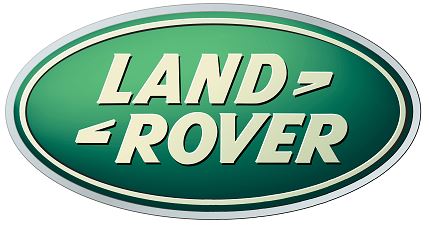
2022 Land Rover Discovery Child Safety

CHILD SEAT SAFETY
Make sure to read and fully understand the relevant warnings before using any of the features in this section. Failure to observe warnings and cautions may result in vehicle damage, injury, or DEATH in the event of an accident.
Always follow the child seat manufacturer’s instructions that accompany the child seat carefully.
Always use a child restraint or booster seat appropriate to the age and size of a child.
Always wear seat belts or use suitable child restraints, for every trip, no matter how short.
Always securely store a head restraint, if removing it in order to fit a child restraint.
Always refit a removed head restraint after a child restraint is removed.
Always make sure the child restraint is correctly anchored.
Never use a forward-facing child restraint until the child is able to sit up unaided. You should continue to use a rearward-facing child seat for as long as possible following the child seat manufactures instructions with regard to age and statue. A young child’s spine and neck are not sufficiently developed to avoid injury in a frontal impact.
Never allow a baby or infant to be held or carried on the lap. The force of a crash can increase effective body weight by as much as thirty times, making it impossible to hold onto the child.
Never use a child seat that only hooks over the seatback. A child seat of this type cannot be satisfactorily secured and is unlikely to be safe for a child.
Even with advanced air bags, children can be killed or seriously injured. Never place a child in any type of child restraint or booster seat in the front passenger seat.
CHILD SEAT OVERVIEW
Make sure to read and fully understand the relevant warnings before using any of the features in this section. See CHILD SEAT SAFETY.
All infants and children should be restrained in a suitable child safety seat. The child safety seat should be appropriate to the age and size of the infant or child.
CHILD SEAT POSITIONING
Make sure to read and fully understand the relevant warnings before using any of the features in this section. See CHILD SEAT SAFETY.
Crash statistics show that children are safest when properly secured in a child restraint system appropriate for the age and weight of the child, in a rear seating position. Failure to use an appropriate restraint system greatly increases the risk of serious injury or death in the event of an accident.
The legislation which governs how and where children should be carried when traveling in a vehicle is subject to change. The driver is responsible for making sure that all regulations in force are complied with.
BOOSTER SEATS
Make sure to read and fully understand the relevant warnings before using any of the features in this section. See CHILD SEAT SAFETY.
A child may be too large to fit into a child safety seat, but too small to safely fit the vehicle’s seat belt. In these circumstances it is recommended that a booster seat is used. Follow the manufacturer’s instructions for the fitting and use of the booster seat. Adjust the vehicle’s seat belt accordingly.
If the booster seat is fitted with LATCH connectors, these should be used to secure the seat in conjunction with the rear seat belt.
CHILD RESTRAINT CHECK LIST
Make sure to read and fully understand the relevant warnings before using any of the features in this section. See CHILD SEAT SAFETY.
Every time a child travels in the vehicle, observe the following:
- Carefully follow the instructions provided by the manufacturer of the restraint system.
- Always use the appropriate child restraints and adjust the harnesses for every child, every trip.
- Make sure that a child falls into the correct weight range for the seat.
- Avoid dressing a child in bulky clothing. Do not place any objects between the child and the restraint system.
- Regularly check the fit of a child seat. Replace child seats or harnesses that show signs of wear.
- Make sure that all the slack is removed from the adult seat belt.
- Make sure that any belt positioning sliders on the seat belts are adjusted such that there is no slack in the lap belt after fastening.
- No child seat is completely child-proof. Encourage a child not to play with the buckle or harness.
- Never leave a child unsupervised in the vehicle.
- Activate the rear door child safety locks. See CHILD SAFETY LOCKS.
- Set a good example and always wear a seat belt.
- When using a seat belt to secure a non-LATCH child restraint, make sure the seat belt’s locking mechanism is used.
- Always attach the top tether when fitting the LATCH seat.
- Carefully follow the instructions supplied with the child seat. Always give the LATCH seat a final pull, to make sure that the lower anchors are secure.
- Always use the appropriate child restraints and adjust the harnesses for every child, every trip.
- Make sure that a child falls into the correct weight range for the seat.
- Avoid dressing a child in bulky clothing. Do not place any objects between the child and the restraint system.
- Regularly check the fit of a child seat. Replace child seats and harnesses that show signs of wear.
- No child seat is completely child-proof. Encourage children not to play with the buckle or harness.
- Never leave a child unsupervised in the vehicle.
- Activate the rear door child safety locks. See CHILD SAFETY LOCKS.
- Set a good example and always wear a seat belt.
CHILD SAFETY INFORMATION
Make sure to read and fully understand the relevant warnings before using any of the features in this section. See CHILD SEAT SAFETY.
Children should travel in the rear of the vehicle at all times. Front passenger seat travel is not recommended. Failure to observe this may result in serious injury, or death in the event of an accident.
Extreme hazard! Never place a rearward facing child restraint on the front passenger seat. The infant could be seriously injured or killed if the air bag deploys.
Child restraint systems are designed to be secured in vehicle seats by use of the lap belts or the lap belt portion of a lap-shoulder belt. Children could be endangered in a crash if their child restraints are not properly secured.
Foldable seats must be in a secure upright position before fitting a child restraint. See ELECTRIC SECOND ROW SEATS.
A child should only travel in the front passenger seat if it is essential and national or state legislation permits it. If this is the case, it is recommended that the following preparations are made before fitting the child restraint:
- Adjust the seat to the rearmost position.
- Adjust the seat cushion to the highest position.
- Adjust the seatback to the optimum upright position to support the child seat.
- Adjust any lumbar support to the minimum support position.
- Adjust any cushion extenders to the fully retracted position.
CHILD SAFETY LOCKS
Make sure to read and fully understand the relevant warnings before using any of the features in this section. See CHILD SEAT SAFETY.
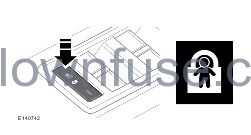
It is recommended that the rear door interior handles are disabled if children are to be carried in the rear seat positions.
Press the switch located on the driver’s door to activate the child door locks and inhibit the rear windows. The LED indicator illuminates when active, and the message center displays a message.
To switch off, press the switch again. The LED extinguishes, and the message center displays a message.
WARNING LABELS
Make sure to read and fully understand the relevant warnings before using any of the features in this section. See CHILD SEAT SAFETY.
Extreme hazard! Never place a rearward facing child restraint on the front seat. The infant could be seriously injured or killed if the air bag deploys.
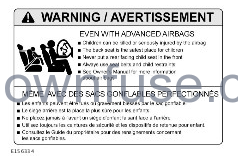
The above label is affixed to the passenger’s side sun-visor. The label warns against the use of a rear-facing child seat in the front passenger’s seat, when a front passenger air bag is fitted and operational.
Never let a child’s head rest near to a front seat side air bag, as an inflating air bag can cause serious or fatal injury.
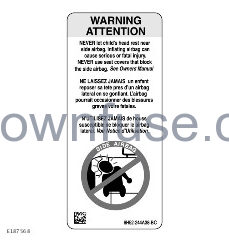
The above label is affixed to both B pillars. The label warns against a child sitting too close to the front seat side air bag.
VEHICLE SPECIFIC INFORMATION
Make sure to read and fully understand the relevant warnings before using any of the features in this section. See CHILD SEAT SAFETY.
Extreme hazard! Never place a rearward facing child restraint on the front passenger seat. The infant could be seriously injured or killed if the air bag deploys.
All children under the age of 4 should ride in the second row seats. Children aged between 4 and 12 should ride in either the second or third row seats.
Even with advanced air bags, children can be killed or seriously injured. Never place a child in any type of child restraint or booster in the front passenger seat.
Always follow the instructions provided by the manufacturer of the child restraint system.
Make sure the child seat fits the child properly. Always check the child restraint system manufacturer’s instructions and labels for height and weight limits.
Before fitting a child seat to a second row adjustable seat, adjust the second row seatback to the upright position to support the child seat.
Do not allow children under the age of 4 use the third row seats.
FITTING LATCH CHILD RESTRAINTS
Make sure to read and fully understand the relevant warnings before using any of the features in this section. See CHILD SEAT SAFETY.
Do not attempt to fit a LATCH child restraint to the center rear seating position. The anchor bars are not designed to hold a LATCH child restraint in this position. Install only using seat belts (non-LATCH system) and the top tether at this position. The child could be endangered in a crash if the child restraint is not properly secured in the vehicle.
If the restraint is not correctly anchored, there is a significant risk of injury to the child in the event of a collision or emergency braking.
Child restraint anchorages are designed to withstand only those loads imposed by correctly fitted child restraints. Under no circumstances are they to be used for adult seat belts, harnesses, or for attaching other items or equipment to the vehicle. This could endanger the child in the event of an accident.
LATCH anchorage child restraints can be fitted to the outer seat positions on the second row seats and both of the third row seats.

To fit a LATCH child seat:
- A label displaying the LATCH symbol is sewn into the flaps, to indicate the position of the LATCH lower anchorages.
- Raise the flap to expose the LATCH anchor points. Slide the child seat locking mechanism into both of the anchor points.
For child seats fitted with non-rigid LATCH connectors, connect the lower tether strap hooks to the anchor bars and tighten the straps.
NOTESIf required, rotate the support strut on the rear of the flap through 90 degrees to lock the flap in the raised position.
Some child restraints are fitted with an upper tether anchorage. See FITTING TETHER ANCHORAGE CHILD RESTRAINTS.
Test the security of the child restraint. To do this, attempt to pull the restraint away from the vehicle’s seat and twist the restraint from side to side. Even if the restraint appears secure, the anchor points should be checked visually, to make sure they are correctly attached.
Always make sure that if an upper tether is provided, it is fitted and tightened correctly.
For child restraints fitted with a support leg, adjust the leg so that it rests firmly on the floor.
After removing a child restraint, always make sure the lower anchor bar flap is fully closed. Failure to fully close a flap could hinder a seat fold maneuver.
FITTING TETHER ANCHORAGE CHILD RESTRAINTS
Make sure to read and fully understand the relevant warnings before using any of the features in this section. See CHILD SEAT SAFETY.
Always follow the child seat or restraint system manufacturer’s instructions when fitting tether straps. The child could be endangered in a crash if the child restraint is not properly secured.
If removing a head restraint in order to fit a child restraint, always secure the head restraint when storing it. In the event of an accident, an unsecured object could cause serious injury.
If a child seat or restraint system is to be fitted to the center seating position, the center armrest must be in the stored position (folded into the seat). In the event of an accident, an unsecured object could cause serious injury.
Tether anchorage points are fitted to the back of all second and third row seating positions. Each tether anchorage point is for the sole use of a child restraint fitted to the same seat.
Do not attach a tether strap to an anchorage point on a folded seat.
Always use the tether anchorage provided with your child seat or restraint system. The tether anchorage should be correctly routed and tightened.
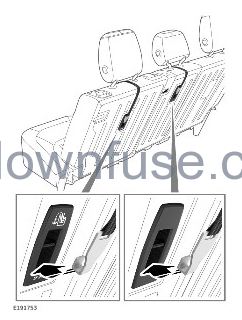
- Fit the child restraint securely in a second row seat.
- Pass the tether strap(s) under the head restraint, between the two head restraint stems.
- Attach the tether strap hook to the anchor point on the back of the same seat. Make sure the strap is not twisted, and that the hook is facing toward the back of the seat.
- Tighten the tether strap(s) according to the child seat manufacturer’s instructions.
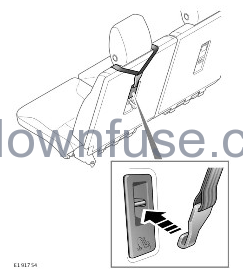
- Fit the child restraint securely in a third row seat.
- If the child restraint has two tether straps, pass one strap around each side of the head restraint. If the child restraint has one tether strap, pass the strap around the left side of the head restraint.
- Attach the tether strap hook to the anchor point on the back of the same seat. Make sure the strap is not twisted, and that the hook is facing toward the back of the seat.
- Tighten the tether strap(s) according to the child seat manufacturer’s instructions.
